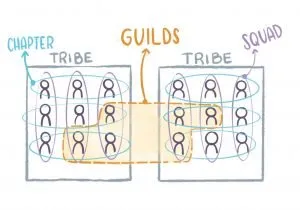10 Practices for Building a Learning Organization: The Guilds
Intré makes training one of its key pillars, as highlighted by one of the three elements in its payoff “Learn / Code / Deploy Value”.
In this article, I will delve into one of the ten practices that Intré implements in itsLearning Organization model: the Guilds.
The 10 Practices of Intré’s Learning Organization
Intré’s evolving Learning Organization model is focused on skill development and the professional growth of its employees. It fosters a collaborative learning environment through targeted practices, encouraging both individual and collective initiative to ensure continuous learning and active engagement within the organization.
Intré’s current learning initiative includes 10 practices:
- Guilds
- Camp
- Community
- Skill matrix
- Certifications
- Academy
- CoP I Wanna Be A Speaker
- Learning objectives
- Classroom training
- Language courses
What do we mean by the term “Guild”? How is it structured? Does it have a specific duration? These are just some of the questions I will answer in the following paragraphs.
The History of Guilds at Intré
Guilds have not always existed in Intré, but were born out of the need to be and remain attractive in the marketplace, as well as to ensure the professional development of one’s employees.
The Will to Continuously Learn: How Guilds Were Born at Intré
Intré has always placed great emphasis on learning and innovation, constantly seeking out new ideas and opportunities for experimentation. In the past, learning took place mainly at an individual level, with occasional exchanges between colleagues.
The growth in the number of team members and an increasing awareness of the potential of continuous learning led to a greater need to promote learning opportunities.
With the aim of enriching both the technical and cultural skills of its employees – and at the same time becoming a competitive and attractive company in the market – Intré introduced Guilds for the first time in 2016.
Guilds, from Guild… the Spotify Model
The Spotify Model made its debut in 2012 when Henrik Kniberg – a coach at Spotify – and Anders Ivarsson published the white paper “Scaling Agile @ Spotify“. This document introduced Spotify’s surprisingly simple approach to agility.
Agile principles form the foundation of this “model”, which organizes work through various units: Squads, Tribes, Chapters, and Guilds.
Guilds are groups that span the entire organization, allowing people from different teams to come together around shared interests, including participants from outside Spotify. They foster collaboration and knowledge sharing among Squads, promoting cross-pollination and the dissemination of expertise across the organization. Essentially, they are interdisciplinary groups created to learn and share knowledge.
Guilds in Practice
How They Are Formed
The formation process for each new Guild takes place during the month preceding the start of the new cycle. Anyone is free to propose a learning topic by submitting a Guild proposal on our dedicated website. It’s the collaborators themselves who suggest the topic to focus on for the next four months of training—without any particular filter, as we’ll see in the following sections. The learning flow that defines the Guilds is bottom-up, and making people the protagonists and owners of their own development is what helps foster motivation and engagement.
A Guild group consists of four to eight people from different teams, with the aim of promoting learning and knowledge sharing.
Each Guild may also include individuals from outside the company, especially in the role of coach, subject to approval by both the internal members and Intré’s management.
Structure and Objectives
Each Guild’s participants dedicate four hours per week over a four-month period to their journey, presenting their results at the next Camp, the company retreat. Each Guild sets a learning objective and commits to delivering a concrete outcome, such as an in-depth article for the company blog, a video podcast, a hardware product, or a software prototype.
Guild meetings, as well as the objectives themselves, are decided self-managed within the group, based on work commitments, aiming to find the best option for everyone.
“Skip the Guild”
Each person has the opportunity, once a year, to skip joining any Guild and instead follow an individual learning path. In this case, they must present a result at the next Camp, as if they were a one-person Guild.
Over the years, several people at Intré have taken part in this unique guild, setting and achieving goals such as:
- obtaining a technical or methodological certification;
- writing an in-depth article on the topic studied;
- completing a university thesis.
The Facigildatori
To ensure the smooth organization of the three annual Guild cycles, specific roles known as Facigildatori have been defined. A Facigildatore is a collaborator who, on a voluntary basis, performs various tasks, including:
- managing the update and development of Intré’s internal portal dedicated to the Guilds;
- preparing and sending periodic communications about the Camps, announcing the opening and closing periods of the proposal and voting phases for the Guilds;
- moderating the meetings where Guild proposals are presented before the voting takes place;
- collecting and archiving the material produced by the Guilds for their presentations;
- facilitating the “Gildonferences”, mini-conferences dedicated to the presentations of recently concluded Guilds, held during the Camps.
Guilds Today
Back in 2016, a Guild cycle included 3 to 4 groups. Today, we run 8 or 9 in parallel — a clear sign of the company’s growth. This means Intré explores around 30 new topics every year.
If you take a look at the evolution of our Guilds over the years, you’ll notice a significant increase — not just in numbers, but also in the variety of topics covered and the learning methods adopted, reflecting Intré’s ongoing development.
From the beginning, the Guilds have focused on exploring technical subjects in depth, offering advanced insights into tools and techniques that support designers and developers in their daily work. Over time, they’ve tackled increasingly complex themes — like the AgiLEGO Guild, which in 2019 created a stop-motion video on best practices and daily Scrum challenges, or the Retro Guild, which dove deep into the concept of retrospectives, experimenting with different approaches.
The Guilds have also led to the development of several internal tools — such as a platform to assess individual technical skills (used in technical interviews), and a monthly reporting portal. Still, the focus is never the product itself, but the learning journey behind it.
As mentioned at the beginning of this article, Guilds are made up of individuals eager to learn and share knowledge around topics of interest — not necessarily limited to software development or design. In recent years, Intré has seen Guilds emerge on subjects like voice acting, theatrical improvisation, craft beer brewing, touch typing, and even one inspired by the iconic fantasy role-playing game Dungeons & Dragons.
In short, Guilds are a key initiative at Intré. They support both personal growth and knowledge sharing among team members, while strengthening the company’s appeal and competitive edge.
What new paths will this learning initiative take in the future? For now, we invite you to stay tuned on our website and social channels to find out.

